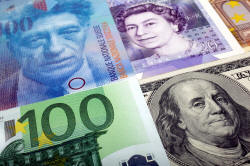Dollar extends losses, euro rallies as traders reassess
rate hike bets
 Send a link to a friend
Send a link to a friend
 [January 13, 2022] By
Tommy Wilkes [January 13, 2022] By
Tommy Wilkes
LONDON (Reuters) - The dollar fell further
on Thursday to two-month lows after U.S. inflation proved weaker than
feared in December, prompting investors to cut crowded long positions in
the currency.
The euro was a big beneficiary of the move and extended its rise to as
high as $1.1479, up 0.3% on the day, while sterling and the yen also
added to their gains.
December's monthly U.S. inflation figures, published on Wednesday, were
a fraction higher than forecast and the increase in year-on-year
consumer price inflation was as expected at 7% - its biggest jump since
June 1982.
Nevertheless, traders do not see these inflation readings as urgently
shifting an already hawkish Federal Reserve too much. With at least
three rate hikes already in the market price, some investors pared bets
on further dollar gains.
The dollar index, which measures the greenback against a basket of rival
currencies, fell another 0.2% to 94.782.

"The scale of the dollar sell-off must surely be partially indicative of
positioning," MUFG analyst Derek Halpenny wrote in a research note.
Halpenny said that so much Fed tightening was now priced in for the next
year, expectations for longer-term rate hikes were relatively low, which
was keeping the dollar in check.
"Investors appear to be signalling that ending QE (quantitative easing),
hiking rates four times and commencing QT (quantitative tightening) all
in the space of (9 months) is so aggressive that it will limit the scope
for hikes further out. It has in fact reinforced the belief that peak
Fed funds will be below 2%," he wrote.
Elsewhere sterling, which has been rallying as traders reckon Britain's
economy can survive a surge in COVID-19 cases and that the Bank of
England is going to hike rates again as soon as next month, rose 0.3% to
$1.3749, its highest since late October.
[to top of second column] |

A picture illustration of U.S. dollar, Swiss Franc, British pound
and Euro bank notes, taken in Warsaw January 26, 2011. REUTERS/Kacper
Pempel/File Photo

The currency is up 4.5% from December lows and traders have so far shrugged off
a political crisis enveloping Prime Minister Boris Johnson, who apologised for
attending a party in the Downing Street garden during a coronavirus lockdown
last year.
The central bank of New Zealand has already begun hiking rates, and the New
Zealand dollar rallied to $0.6884, a gain of 0.5% and its strongest since late
November.
Australia's dollar, which tends to perform well when broader market sentiment is
improving, added 0.4% to $0.7314.
The Canadian dollar reached a new two-month high, rallying as oil prices gain,
with investors looking past the potential economic fallout of the Omicron
variant.
"The dollar does not have to increase because the Fed is readying a tightening
cycle," said Commonwealth Bank of Australia strategist Joe Capurso.
"It is not a simple equation of Fed hikes equals dollar increases. The dollar is
a counter-cyclical currency which decreases as the world economy recovers."
(Additional reporting by Tom Westbrook in Sydney; Editing by Raissa Kasolowsky
and Alex Richardson)
[© 2022 Thomson Reuters. All rights
reserved.]This material may not be published,
broadcast, rewritten or redistributed.
Thompson Reuters is solely responsible for this content.
 |